2006 VOLKSWAGEN GOLF PLUS roof
[x] Cancel search: roofPage 13 of 541
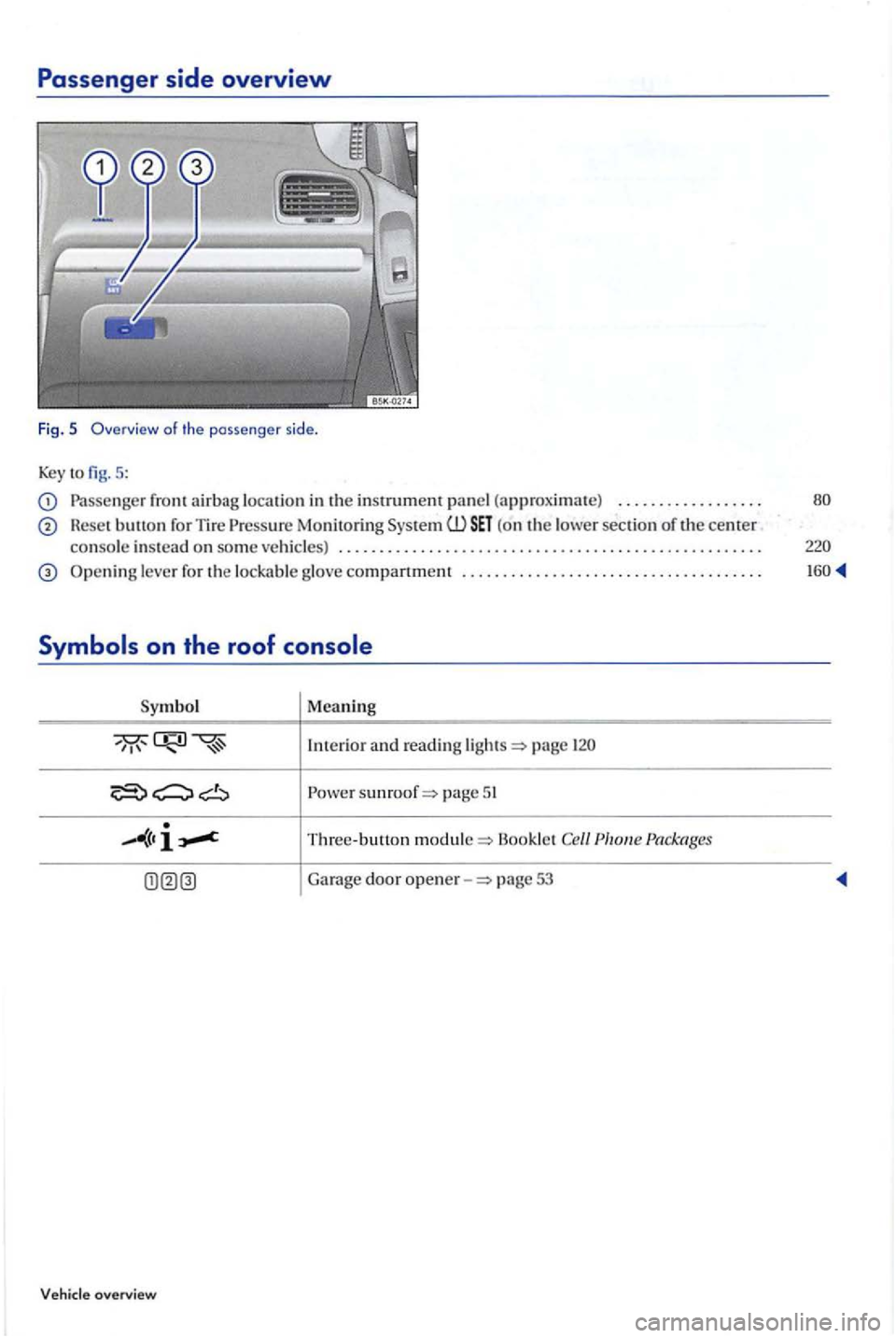
Passenger side overview
Fig. 5
5:
Passe nger front airbag location in the instrument pa ne l (approx imate) . . . . . . . . . . . . . . . . . .
Reset bullo n for Tire (o n th e lower section of Lhe center co nsole in stead on so me ve hicl es) . . . . . . . . . . . . . . . . . . . . . . . . . . . . . . . . . . . . . . . . . . . . . . . . . . . .
Symbol Meaning
Interior and reading p age
sunroof=> page 5 1
Three-buuon module=> B ook le t
53
overview
Page 43 of 541

minutes. onl y the outer button on the driver door is affected, o nl y thi s button is deactivat ed.
The sensors become active again if one of the following events occurs:
minutes have pass ed.
OR:The vehicle is unlocked usin g button in the vehicle key.
order to uti lize convenience closing of all power window s and the power sunroof. press the outer button on the door handle for at least
the outer button in ord e r to stop the process.lfthe outer button on th e door handle is acti va te d a gain immedia te ly aft er it relea sed,
all windows are ope n ed (safe ty fun cti on) page 48.
Anti-theft system
lir st read and note the introduc tory information and heed the on page38.
The anti-theft alarm sys te m makes it more difficult
for someon e to break into or ste al the vehicl e.
The anti-theft alarm system is automati cally acti vated when th e ve hicle is locke d b y pressing the lock button on th e vehicle key (remote control
k ey).
When is the alarm trigg ered?
The anti-theft a larm system sounds fo r ab out seconds and fla shes the turn signals fo r up to minutes if the f ollowing a c ti ons are performed on the locke d vehicl e:
Opening been mechanic ally unlo cke d and not swit ching on the ig n ition w ithin about
Forcibl y opening a door.
Forcibl y opening the engin e hood.
Forcibl y opening the rear h atc h .
on the ig nit io n an invalid or unprogrammed key.
Before driving
Door opening is performed ac cording to the settings ac tivate d in the corresponding m enu Settings -Convenience a door handle is being
page
at least o ne power window is open and the sensor i s continuously activated, the convenience clos ing starts .
page
the ele c troni c ste e rin g column lock will not lo ck and the ve hi cle
hide ke y is discharged or it might not be possibl e to unlock and lo ck the vehicle using
D isconnecting the vehicle battery.
Deactivating the alarm
Unlock the ve hicl e with the unlock button on the vehicl e key or swit ch on the ignition with v alid vehicle key.
aft er the alarm h as stoppe d, the v ehi cle is opened aga in in the same or a differ ent area pro tecte d b y the alarm, the alarm sound again if the rear h a tc h is o pen ed after one of the doors has been o pe ned.
T he anti-theft alarm sys te m i s not activa te d w hen th e vehicle is locke d with the lock swit ch
th e driv er door is unloc ke d u sing the ve
the ve hicle battery is disc harge d or weak, not w ork properly.
Page 52 of 541
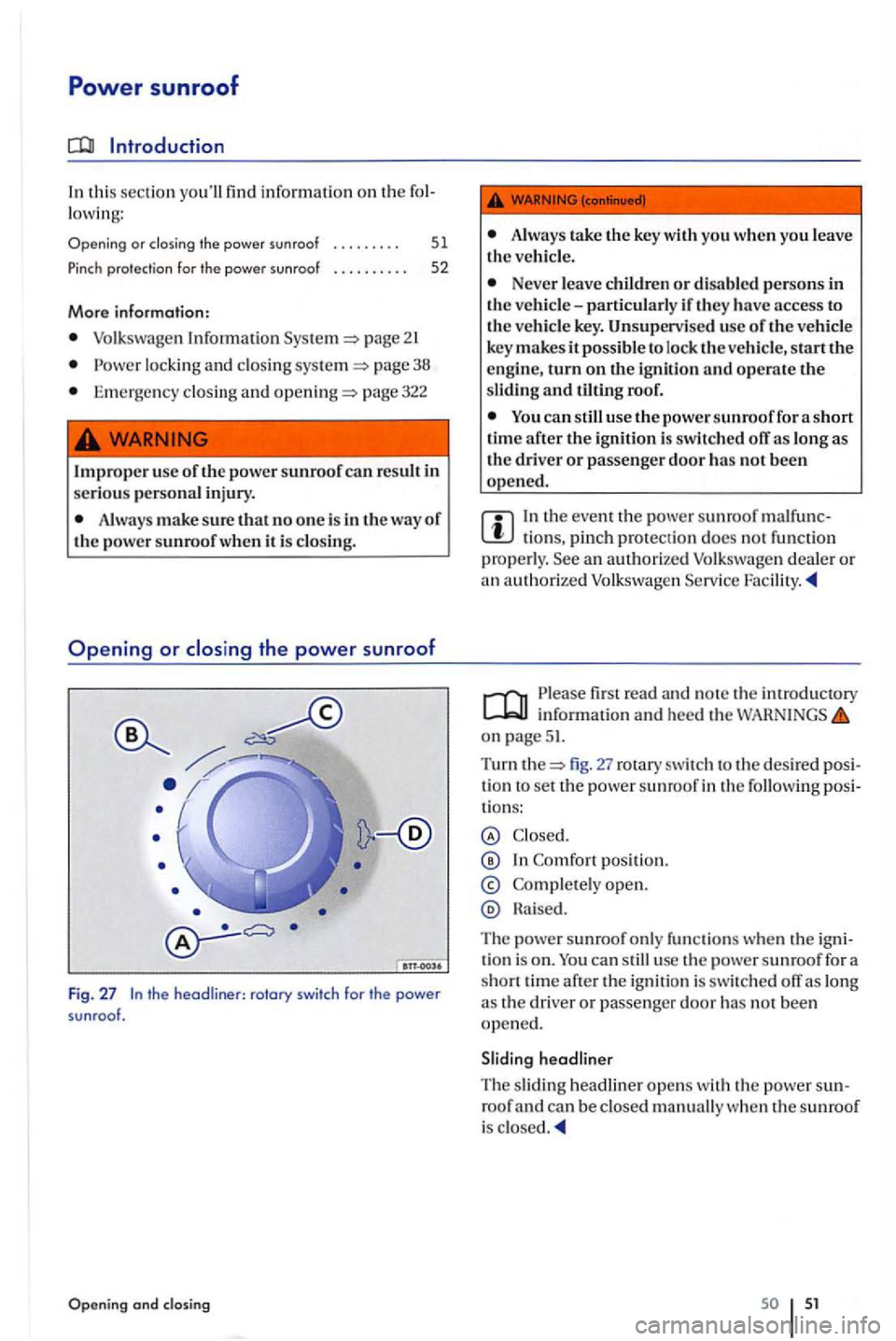
Power sunroof
In this sectio n lowing:
Opening
or closing the power sunroof
Pinch pro tection lor the power sunroof
More information :
Volkswagen lnfom1ation page 21
page 38
Em erge ncy closi ng and p age 322
51
52
Improper use of the power sunroof can result in seri o us personal injury.
Always make sure that no one is in the way of th e power sunroof when it is clo sing.
Opening or
Always take the key with you when you leave
t h e ve hicle.
Never leave children or disabled persons in the vehicle -particularl y if th ey have access to
t h e ve hicl e key. Unsuperv ised usc of the vehicle
key makes it poss ible to loc k th e vehicle , s tart th e
e ngine, turn on the ignition and operat e the s liding and tilting roof.
In the event the sunroof pin ch prot ection docs not fu nction p roperly. an authorize d Volkswage n dealer or
a n auth orized Volkswage n Se rv ice
fir st read and no te th e imroductory information and hee d th e on page 51.
Turn fig. 27 rotary switch to th e desired tio n to set th e power sunroof in the tions:
Co mple te ly open.
H ai se d.
Th e
sunroof o nl y fun ctions w he n th e
headliner
Th e sliding h
eadliner opens with th e power roo f and can be closed when th e sunroof
i s
so 5 1
Page 53 of 541
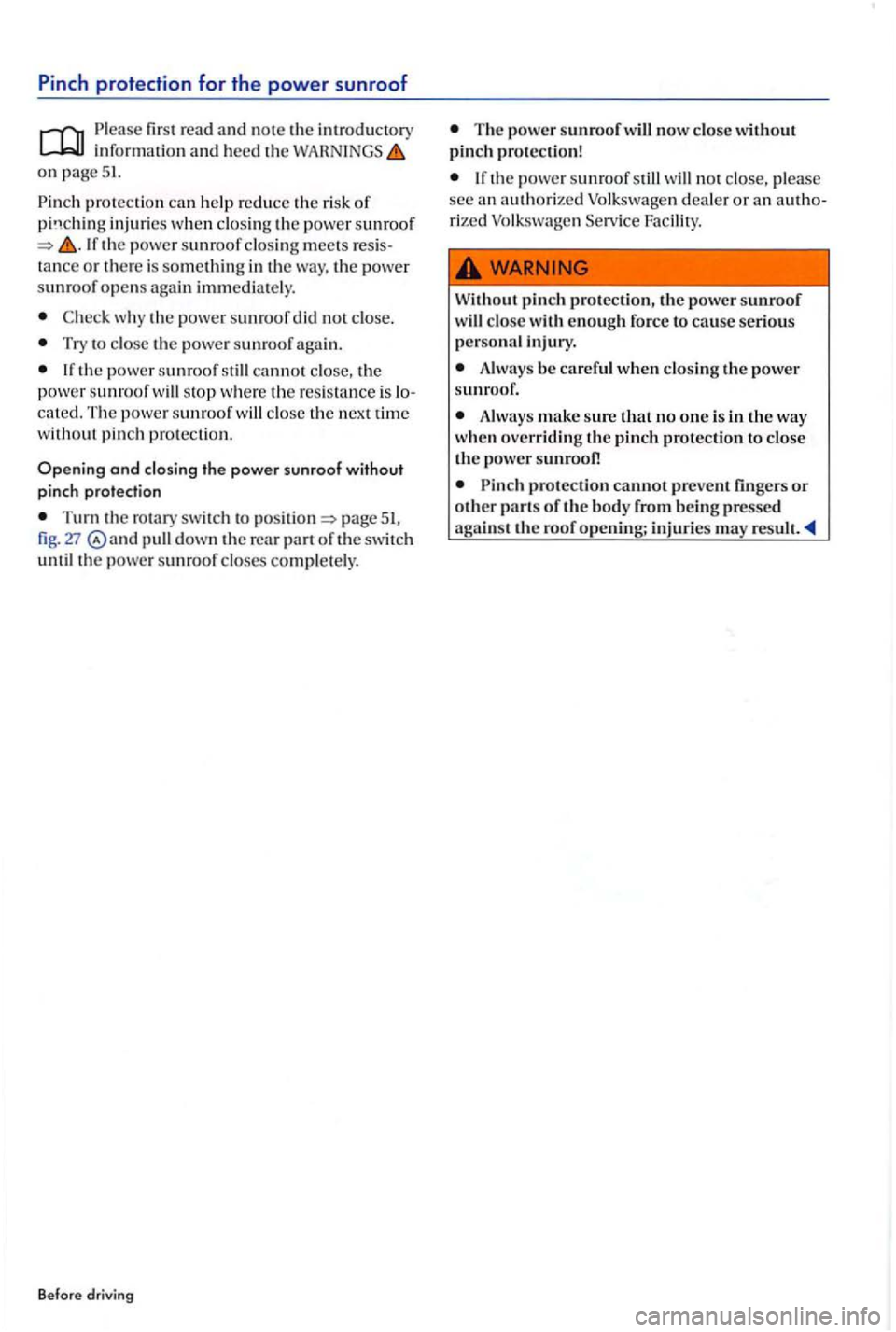
Pinch protection for the power sunroof
Please fir s t read and no te the introductory informatio n and heed th e on page 51.
Pinch p ro tection ca n help re duce the ris k of in juries when clo sin g th e pow er sunroof If th e pow er sunroof c lo sin g meets
immediately.
why the power sunroof did not close.
T ry to clo se the power sunroof aga in.
clo se, the power sunroof will sto p whe re th e re sis tance is ca ted. The powe r sunroo f w ill cl ose th e next time
wit hout pin ch pro tection.
Openin g and closing th e power su nro of w ithout
pinch protecti on
Turn th e rotary switch to page 51, fig.
T he powe r sunroof will now close without
p in ch p rotec tion !
If the powe r sunroof still will not close , please sec deale r or an Service Facility.
Without pin ch protec tio n, th e powe r sunro of
w ill close with en oug h force to cause seri ous
p e rso na l injury.
Alwa ys ca reful when closin g th e power
sunroof.
A lw ay s make sure that no one is in th e way
w he n overrid in g th e pin ch protectio n to close th e power sunroof1
Pin ch protectio n cannot preve nt fingers or
o ther pa rt s of th e
Page 90 of 541
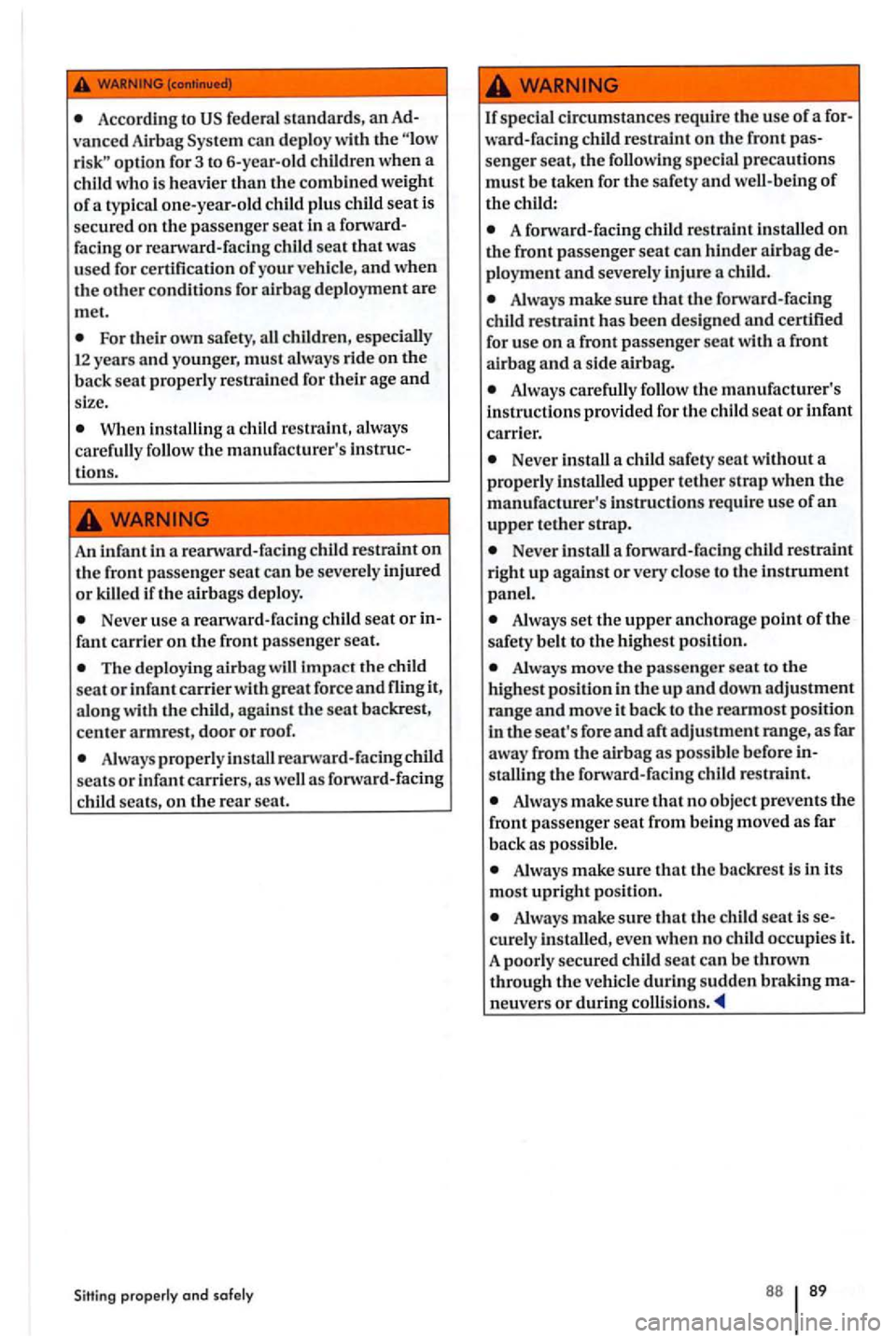
According to US federal stand ards , an vanced Alrbag System can deploy with the
For their own safety, all children, especially 12 years and younger, must always ride on
When installing a child restraint, always
carefully follow the manufacturer's instruc
tion s.
An infant in a reanvard-facing child restraint on the front passenger seat can be seve rely injured or killed if the airbags deploy.
Never use a reanvard-facing child seat or
The deploying airbagwill impact the ch ild
seat or infant carrier with great force and fling it,
along with child, against the seat backrest,
center armrest, door or roof.
Always properly reanvard-facingchild
sea ts or infant carriers, as well as fonvard-facing
child seats, on
ond
If special circumstances require the use of a
senger seat,
A forward-facing child restraint installed on
ploym ent and severely injure child.
Always make sure the fonvard-facing
child restraint has been designed and certified
for use on a front passenger seat with a front
airbag and a side airbag.
Never install a child safety seat without a
properly installed upper tether strap when the
manufacturer 's instructions require use of an upper
Never install a fonvard-facing chil d restraint
right up
Always set the upper anchorage point of the
safety belt to the highest position.
Always move passenger seat to
rearmost position in seat's fore and aft adjus tment range, as far
away from
stalling
Always make sure that no object prevents tJ1e
front passenger seat from being moved as far
back as possible.
Always make sure that the backrest is in its
mo st upright position.
Always make sure that the chil d sea t is curely installed, even when no child occupies it.
A poorly secured child seat can be thro wn
through the vehicle during sudden braking
88 89
Page 110 of 541
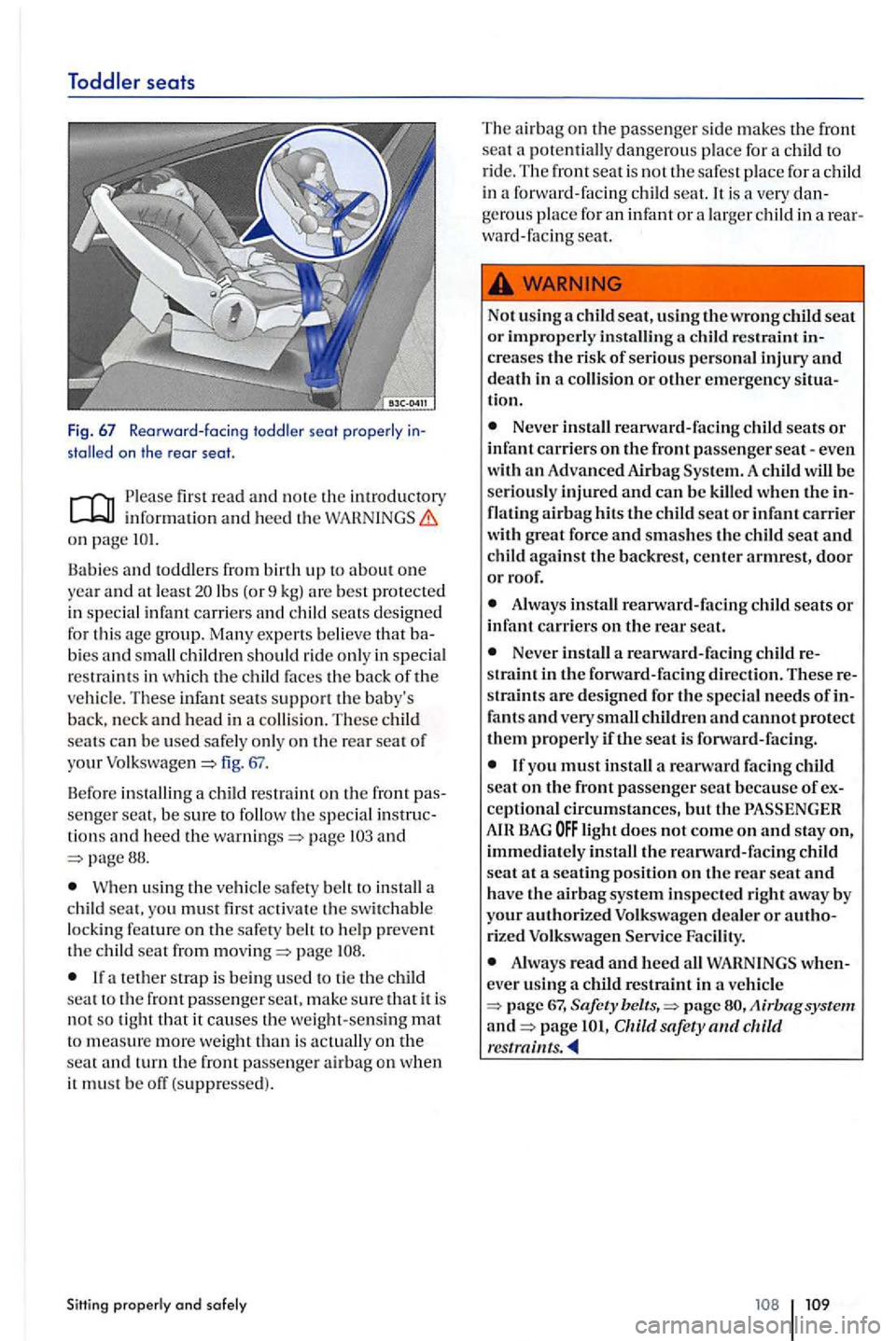
Please first read and note th e introductory information and heed the on pag e
Babies and toddlers from birth up to about one year and least lbs (or 9 kg) best protected
in spec ial infant carrier s and child seats designed
for this age group. Many experts believe that ba
bies and s mall children sh ould ride only in s pecial
r es traint s in which the child faces the back of the
ve hicl e. These infant seats support the bab y's
back, neck and head in a collision. These child
sea ts ca n b e use d safe ly on ly on th e rea r seat of your fig.
page and 88.
Whe n using the vehicle safety belt to install a
c hil d seat, you mu st fir st activate the switchable
lockin g fe ature on th e safe ty belt to help preve nt
th e c hild seat from pag e
tether strap is being used to tie th e child seat to th e front passenger mak e sure that it is not so tight that it causes the weight-sensing mat to measure more weight than is actu ally on the seat and turn the front passenger airbag on when it mu st b e (suppre ssed).
SiHing properly and safely
The airbag on th e passenger side make s the front
sea t a pot entially dangerou s pla ce fo r a child to
ride. The front seat is not the s afes t place for a child
in a forward-facing child seat.
is a very dange rou s place for an infant or a larger child in a rear
ward-fa cin g seat.
Not using a child seat, usi ng the wrong child seat or improperly installing in
creases the risk of serious personal injury and death in a collision or other emergency situa
tion.
Never install rearward-facing child seats or infant carriers on the front passenger seat-even
with an Advanced Airbag System. A child will be seriously injured and can be killed when the in
flating airbag hits the child seat or infant carrier
with great force and smashes the child seat and child against the backrest, center armrest, door or roof.
Always install rearward-facing child seats or infant carriers on the rear seat.
Never install a rearward-facing child re
s traint in the fonvard -facing direction. These re
s traint s are designed for the special needs of in
fants and very small children and cannot protect them prope rly if the seat is fonvard-facing.
you must install a reanvard facing child
seat on the front passenger seat because of ex
ceptiona l c ir cumstances, but th e BAG light does not come on and stay on, immediately install the reanvard-facing child seat at a seating position on the rear seat and have the airbag system inspected right away by your authorized Volkswagen dealer or authorized Volkswagen
Always read and heed all in a vehicle =>page 67, Safety belts,=> pag e page safety
Page 126 of 541
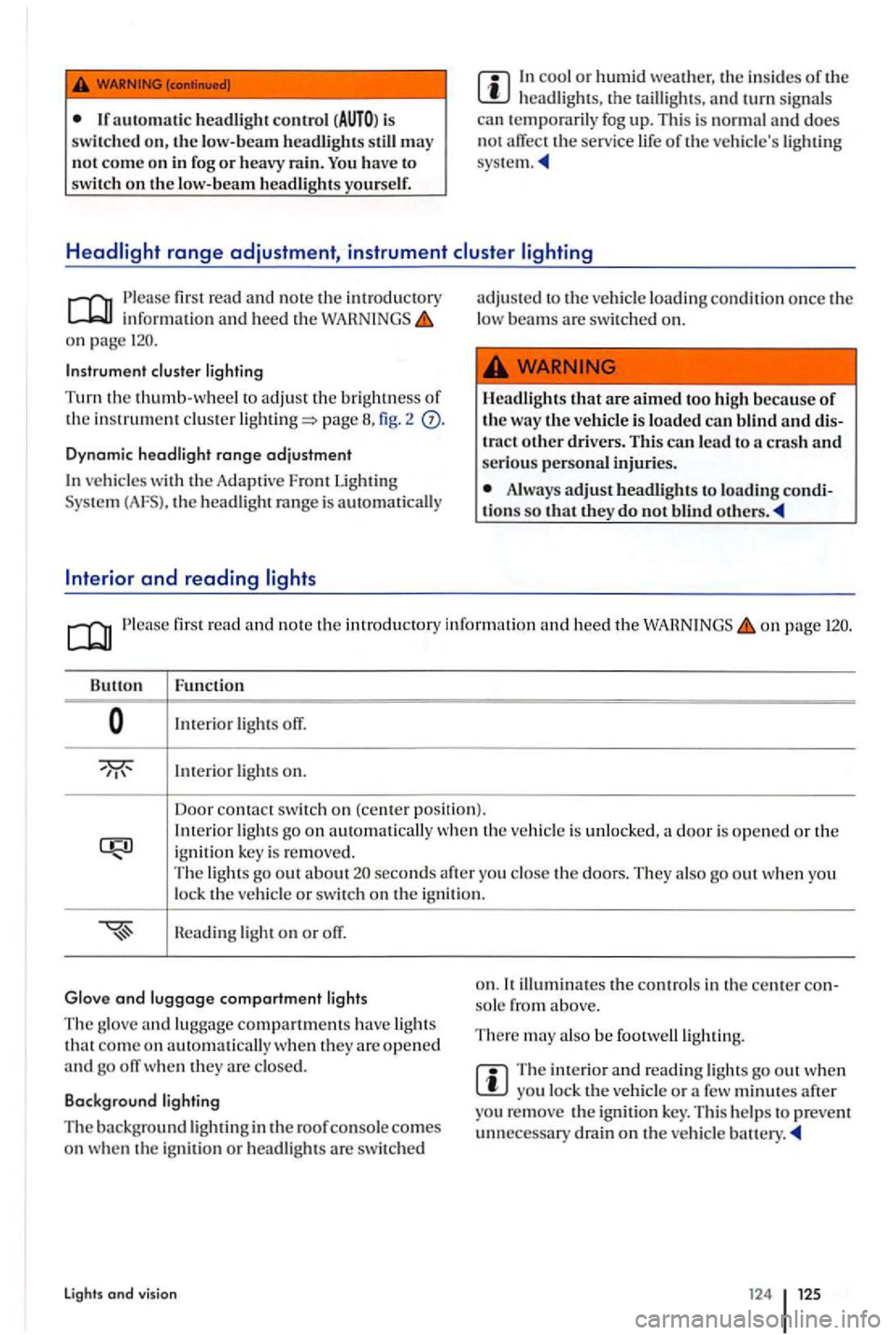
may not come on in fog or heavy rain. You have to
s witch on the low-beam headlight s yourself.
cool o r h umid weather, th e in sid es of th e headligh ts , a nd turn sign als
can t e mporaril y fog up. Thi s is normal and does not affec t th e servi ce life of th e ve hicle's lighti ng
read and note t h e intr oductory
o n page
Instrum ent
page
Dynamic headlight range adjustment
ve hicles with the Adaptiv e Front Lighti ng th e hea dlight range is automati cally
adj uste d to the ve hicl e loading con dition once the
l ow bea ms are switch ed on.
H
eadli ghts that are aimed too high because of the way the vehicle is loaded can blind
Always adjust headli ght s to load ing
page
Int erior lig ht s off.
lmerior light s on.
Door conta ct
switch on (ce nter positio n). Int erior lig ht s go on wh en th e ve hicl e is unlock ed ,
seconds after th e doors. They also go out when you
lock th e
come on automati cally w hen they are open ed and go off when th ey are closed.
Background lighting
T he
background lighting in the roof console comes on w he n th e ig nit ion or headlig hts are s wit c hed
lights and v ision
o n . so le from above.
There m ay also be foo twe lllighting.
Th e interio r and rea din g lights go out when yo u lock the ve hicle or a few minutes aft er
yo u re m ove the ign ition key. Thi s help s to p reve nt
un necessary drain on the vehicl e
Page 139 of 541
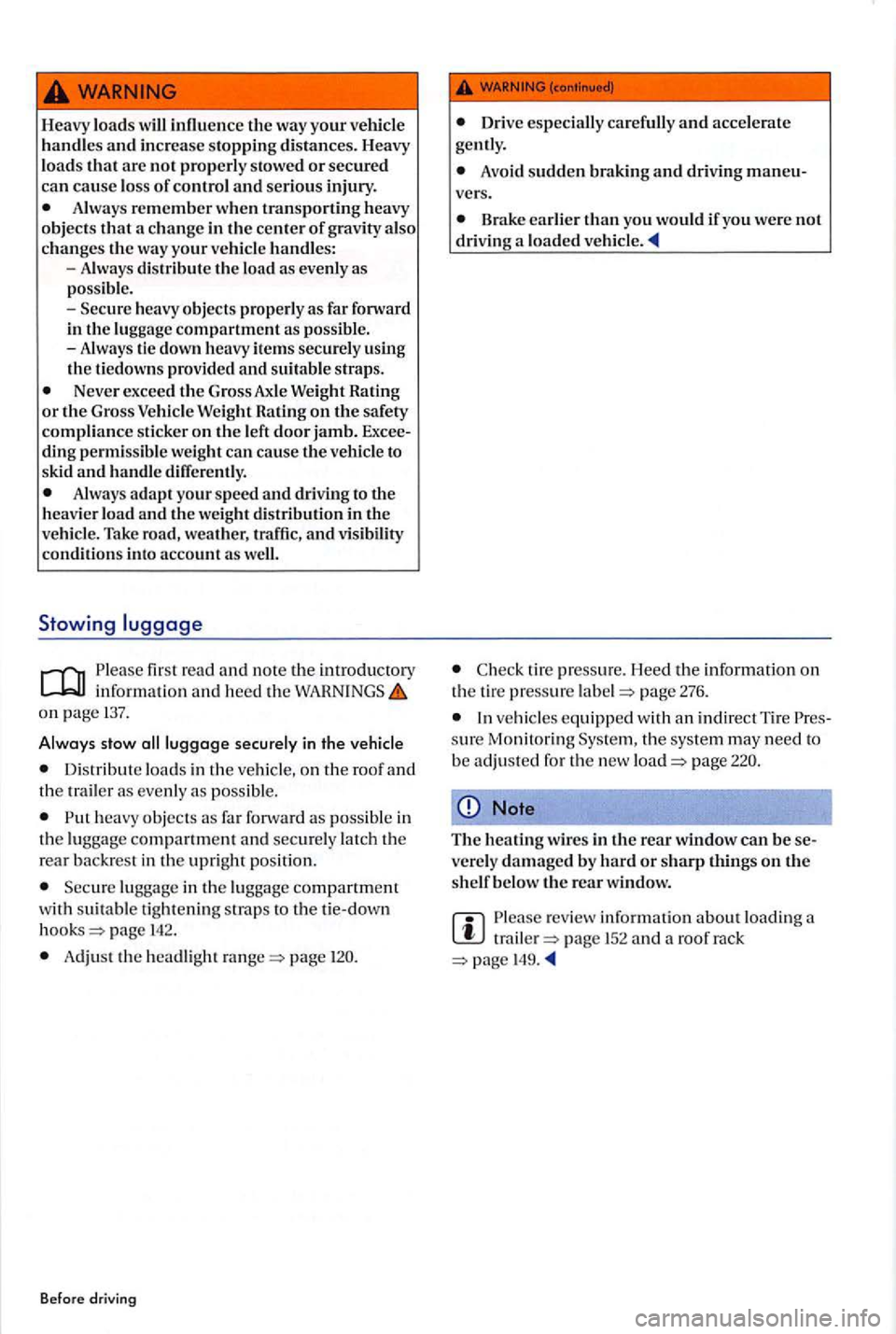
Heavy loads innuence th e way your vehicle handles and increa se stopping distances. Heavy
load s that arc not properly stowed or secured can cause los s of contro l and serious injury . Always remember when transporting heavy
objects that a change in the center of gravity also
changes the way your vehicle handles:
- Always dis tribute the load as evenly as
possib le. -heavy objects properly as far forward
in th e luggage compa rtme nt as possible.
- Always tie down heavy items secure ly using
th e tiedowns provided and suitable straps.
Never exceed th e Gross Axle Weight Rating or the Gross Vehicle Weight Rating on the safety compliance sticker on the left door jamb. Excee
ding permissible weight can cause the vehicle to
skid and handl e diff erentl
y.
Always adapt your speed and driving to th e
heavi er load and the we ight distribution in the
vehicl e. Take road, weathe r, and visibility
cond itions into acco unt as we ll.
Stowing
on page 137.
Always stow all luggage securely in the vehicle
Distribut e loads in the vehicle, on th e roof and the trail er as even ly as possible.
Secu re lu ggage in the luggag e compartment with suit able tightening strap s to the tie-down page 142.
Adjust the headli ght page
Before driving
Drive especia lly carefully and accelerate
gently.
Avoid sudden braking and driving maneu
ve rs.
Brake earlie r than yo u would if you were not driving a loaded
tire pressure. Heed the information on the tir e pressure page 276.
sure Monitor ing Syste m, the system may need to
be adjusted for the new page
CD Note
The heating wires in the rear window can be se
vere ly damaged by hard or sharp things on the sh elf below the rear window.
review inf ormation about loading a page 152 and a roof rack 149.